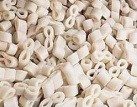Get Your Fill of Packing Peanuts

The packing peanut was first invented in 1965 by Robert E. Holden and to this day is still one of the most important aspects of the shipping process. These little gems, whether made of Styrofoam or biodegradable sorghum, act as a filler for your box of shipped goods as they interlock when compressed in a small area helping keep your item safe on its travels.
General Use
Though packing peanuts now come in a large variety of shapes, the ideal ones for shipping are either the traditional “S” configuration or the increasingly popular “8” frame. The two shapes offer the best cushioning memory and resist migration.
Ideally, packing peanuts should be used to fill the void surrounding items packed in a box to ensure there is little movement throughout the shipping process. They should only take up a space that measures between 2 to 4 inches (5.1 to 10.2 cms) around the item. If used in a space smaller or larger than that, they will not be able to securely keep the item in place.
Packing peanuts also only work best with items that are 45 pounds (20.4 kgs) or less. Anything heavier will compress them to a point where they won’t provide enough protection.
White Peanuts
Although white peanuts have been the most popular type over the years, they have static properties. When packing electronics, the best type of peanuts to use are either the anti-static or recycled ones.
No matter which kind of packing peanuts you use, always line the bottom of the box with a minimum layer of 2-inches (5.08 cms) before placing the items in the box.
Biodegradable Peanuts
The most recent wave in the packing peanuts industry are the biodegradable ones made with natural products such as the grain sorghum or corn starch. Although these are much better for the environment, they are not recommended by The UPS Store. The problem with these types of peanuts is that they can easily lose density, memory or resilience if the package gets wet or is subject to humidity.
For Books or Clothes
Packing peanuts are not recommended when shipping unprotected books or multi-page documents. The peanuts can get lodged between pages or inside the covers of the book, causing damage to the item. Another product to avoid packing directly with peanuts are clothing items as they may rub off on the material and possibly ruin sensitive fabrics.
When shipping either books or clothes, it is always best to put them in plastic wrap or a bag first before surrounding them with the peanuts inside the box.
How Much Is Needed?
For best protection of your items, packing peanuts work best when the shipping box is overfilled with them by between 5 and 10 per cent. Throughout the shipping process, they will settle and provide protection on all sides of your item. The one thing to keep in mind is that as they settle, they will move around within the box. As such, ensure the item is protected such that those little foam pieces can’t dig their way into areas that could cause damage.
If you receive a package with non-biodegradable peanuts, don’t fret. You can re-use them the next time you need to ship something. They can also be used for your kids’ next art project, can help add life to an old bean bag chair, or can be used as filler for your garden planters as they offer drainage for your plants and are much lighter than rocks or soil. Also, many The UPS Store locations accept clean foam packaging peanuts for reuse.
If you need packing peanuts (or other packaging supplies) for your next shipment, visit your local The UPS Store.


